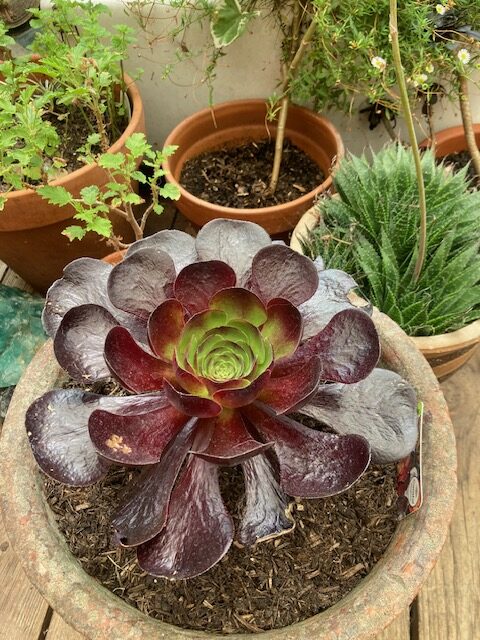I have bought a brand new, long-hankered-after plant this summer that might just make my greenhouse a little less full to bursting this winter: a ‘semponium’. I have long loved Aeoniums – beautiful succulents the most well known of which is ‘Zwartkopf’, which has almost black rosettes of leaves on sinuous stems. I think I am particularly fond of them because they remind me of our family holidays in Cornwall, where you see them everywhere. Aeoniums are native to the Canary Islands, and as such as fairlty tender but also suited to the conditions that can be found in your Cornish clifftop garden: mild winters and warm summer, and a maritime climate with very little if any frost. There they rub shoulders with big blue agapanthus, with spiky agaves, with all sorts of other beautiful and semi-tropical plants that are just hardy enough to fool someone living in Bristol that it is worth having a go.
And this is the tricky thing about them. They are definitely slightly hardier than most succulents, and they can survive most mildish city winters pretty well, particularly if given a little cossetting. I put mine into my little mini greenhouse and sometimes wrap some fleece around them and they mostly come through very well. But this fools you: every now and then a very cold winter spell comes along, and this can devastate them, and I have built up collections of them only to have them all wiped out in one cold snap.

Apparently I am not the only person this has been bothering because a few years ago at Chelsea Flower Show I came across a stand of ‘Semponiums’. These, the nurseryman told me, were their own cross between aeoniums and sempervivums, a low-growing succulent which is commonly known as the house leek, and is very hardy – it used to be planted among roof tiles as it was thought to ward off lightning strikes. The result were plants that looked very like those Cornish aeoniums, but which were apparently almost as hardy as the house leeks.
I really wanted one, but the plants the nurseryman had for sale were eyewateringly expensive. This is the nature of a new plant: the nurseryman will have put years of development and testing into the plant at this stage of the game and also hasn’t had a chance to bulk them up to grow for the wider audience, and so there are only relatively few plants, and all of them cost a lot of money. I decided to wait a few years and see if they caught on and became more widely grown, also reckoning that if their claims at hardiness were to prove lacking, it would be good if it wasn’t my £50 plant that discovered that.
Lucky me, I was in the garden centre earlier this summer and there they were, still not exactly cheap but much lower in price, and yes, cheap enough to treat myself. I chose this dark, almost black type, ‘Destiny’, which surely must be descended from ‘Zwartkopf’. I have planted mine in a pot for now, in well drained compost – as much as I would love to plant it into my border I really can’t quite trust it yet, and when it comes time to tuck my other aeoniums away for the winter in mid autumn I will try to force myself to leave it out, tempting as it will be to tuck it away into the greenhouse for safety.
I hope it will be a part of my summer planting for many years to come, bringing a little slice of Cornwall to my Bristolian terrace.


